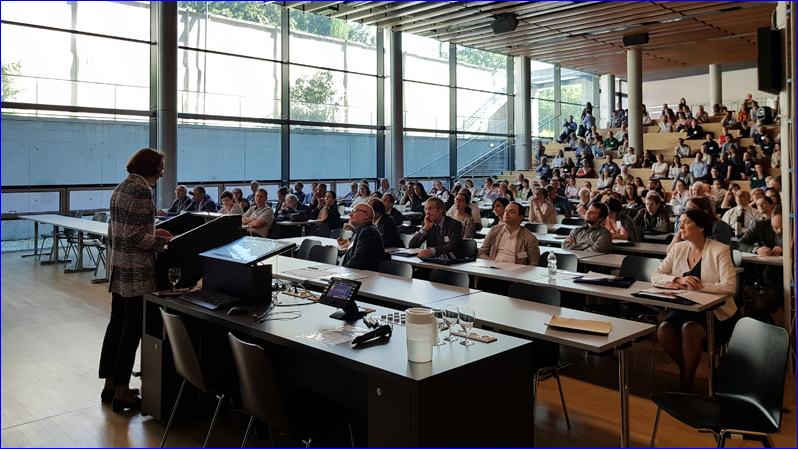


 AINA)
AINA)
The theme of the conference was "The Intellectual Heritage of the Ancient Near East," which places the Ancient Near East with its knowledge and culture stored in the early writing systems along with its historical reception under particular focus. The theme of the 64th RAI coincides with the scientific aims of the Melammu Project, corresponding to the investigation of the continuity, transformation, and diffusion of Mesopotamian and Ancient Near Eastern cultures from the third millennium BC through the Ancient World until the Islamic periods and after. It is also particularly focused on the continuity of the Ancient Near Eastern Cultures into the present world and their cultural influence on the western scientific thought.
Related: Akkadian Words in Modern Assyrian
RAI is five-day major annual conference event within the academic discipline of Ancient Near Eastern Studies, the scientific study of oriental antiquities through archeology, philology (especially cuneiform script) and historical research, attracting scholars at different stage of their career, interested in Assyriology, Ancient Near Eastern History, and Archaeology.
The conference was opened on Monday, July 16th with welcoming speeches from the management of the University of Innsbruck by Professor Ivo Hajnal, Chairman of the Senate, Professor Elisabeth Dietrich-Daum, Chairwoman of the Faculty Council of the Faculty of Philosophy and History, and Professor Robert Rollinger, Head of the Department of Ancient History and Near Eastern Studies, who is also member of the organizing committee. Professor Hajnal mentioned that so far the conference has been held just one time in Austria, organized by the university of Vienna in 1981 and stressed that the University of Innsbruck is honored hosting this annual event. In fact, RAI is regarded to bring great academic prestige to the hosting institutions and to the hosting countries. By hosting a RAI at Innsbruck the relevant departments hope to gain more visibility within the international academic discussion while presenting their scientific results to the interdisciplinary field.
Following the welcoming speeches, Simonetta Ponchia, Assoc. Professor of History and Ancient Near East from the University of Verona, spoke as Chair of the Melammu Project. She outlined the objectives and status of the Melammu Project, which aims "to investigate the continuity, transformation, and diffusion of Mesopotamian and Ancient Near Eastern culture from the third millennium BC through the ancient world until Islamic times and after." Professor Cécile Michel, Universities of Paris and Hamburg, and current President of the IAA, spoke about the Association that was founded in July 2003, after the looting of the Iraq Museum at Baghdad, in order to promote the fields of cuneiform studies and Near Eastern archeology on an international basis and to act as a representative body for these fields in relationship to national, international and private institutions, as well as the general public. Because of the deteriorating situation in the Near East, the IAA published several statements in the past several years about the humanitarian crises and the challenges facing cultural heritage in the region. The IAA has made "a public appeal for the preservation and the protection of the sites, monuments, and museums of Syria and Iraq."
The first Keynote speech was delivered by Professor Simo Parpola, University of Helsinki, who spoke on "The Beginnings and Progress of the Melammu Project." He mentioned "growing up in this research tradition," worked on the Assyrian Dictionary of Chicago, and was founding member of the Melammu project in 1998. The 1st Symposium was organised in October 1998 under the Title "Heirs of Assyria."
The current on-line resources provided by the project include a database, a bibliography, a document library, and links to websites relevant to the project's focus. The database aims to collect textual, art-historical, archaeological, ethnographic and linguistic evidence concerning the heritage of Mesopotamia and the Ancient Near East and to make it easily accessible on the Internet. All resources are open-ended, and everyone is invited to contribute new information through the website's submission forms.
The second keynote speech was given by Professor Beate Pongratz-Leisten on "Once more: Puritans in Babylon -- Tracing Approaches to the History of Religion in Mesopotamia." Her publications include several books on the cultural and religious history of ancient Mesopotamia. She just published a monograph on the topic Religion and Ideology in Assyria reconstructing the cultural discourse of Assyria from the third through the first millennium BC. Starting with the bible-babel controversy, in her speech she gave a comprehensive overview about the relevant literature since.
The third keynote speech was given by Prof. Dr. Josef Wiesehöfer on the topic of Alte Geschichte und Alter Orient (Ancient History and Orient).
This year's conference comprised of approximately 150 lectures organized in 20 sessions and 17 workshops, providing a comprehensive overview on the current scientific discourse in the field. The attendance of the conference was estimated at about 500 scholars from several countries of the world. Up to seven parallel session took place to manage the presentations of the academic papers.
In an interview with the Austrian radio station, Professor Rollinger said that the goal of these sciences and the conference is "to make the connection of our present with these seemingly so far cultures clear." The region, with which the ancient Near Eastern history deals is what we call the Middle East (Turkey, Syria , Iraq, Iran, etc.) today. There, the writing was invented in the 4th millennium BC. Rollinger calls this area a "hotspot of world history."
"Today we are talking about a digital revolution," said Rollinger. "But one of the first great revolutions that changed human history was the invention of scripture." The alphabet we use today also goes back to this area of the Ancient Near East. Thus "one of the most important and greatest communicative revolutions in this space has taken place and connects our present with these epochs."

or register to post a comment.